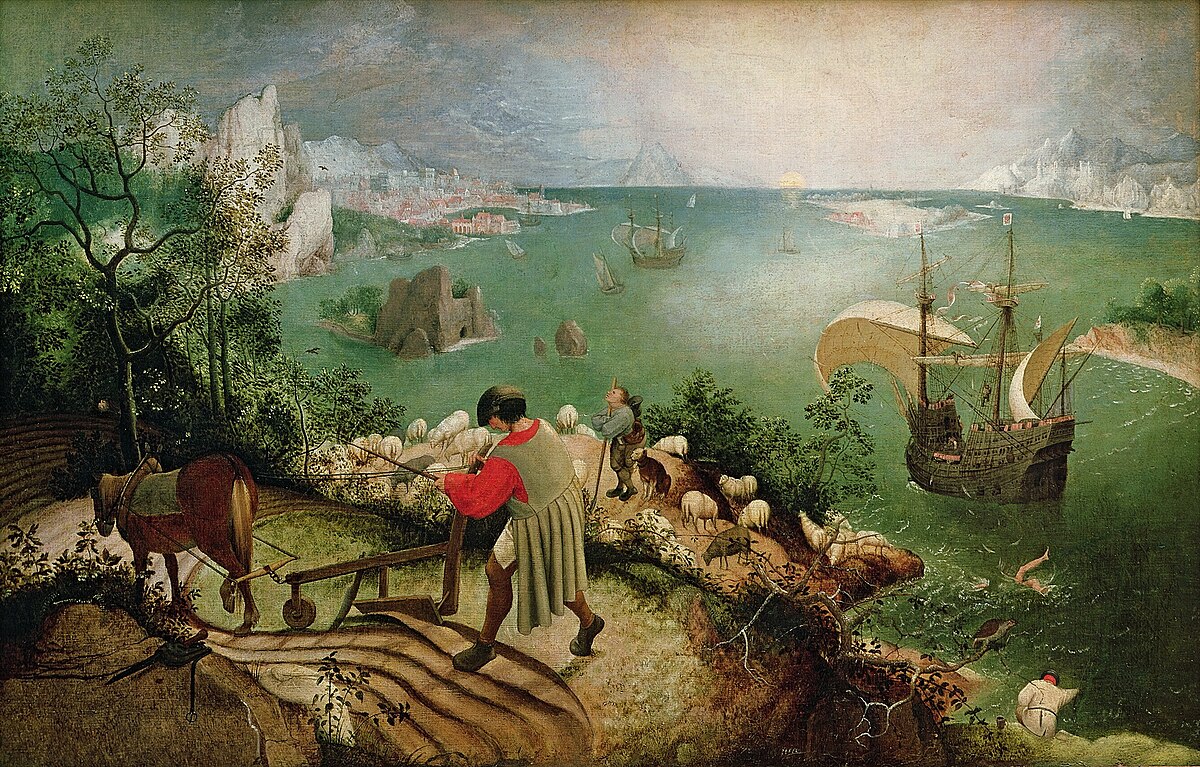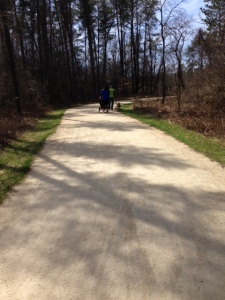If nature abhors a vacuum, perhaps the God of creation does as well, since there may be no difference between God and nature. Leaving old things behind makes space for the new. I kept my eyes open to this new landscape. This was important in order not to fall while walking. The ground dictated the journey: paved surface meant we could make time, inclines called for a slower pace, large rocks required attention to footing, smaller rocks and gravel taxed feet and legs.
The journey was a holistic, unifying one. Body, mind, and soul walked as one; everything was labor, sometimes easier, sometimes harder. I was my feet, and was deeply blessed in that respect. Most pilgrims asked one another: where did you start? How are your feet? My husband got big blisters that turned purple; I got none.
Pedrouzo, May 26: This is an opportunity to pay attention to bodily needs: gotta have a toilet! Don’t forget to drink! My feet tingle, my skin burns, my legs are stiff. Nothing super spiritual.
One day before we entered Galicia, we stopped, and he asked me to go to a pharmacy (farmacia, ubiquitous along the route) for some bandages of a particular size. When I entered, I discovered a sizeable section devoted to foot care, with a dazzling variety of bandages, supports, and ointments for toes and feet. (This is one of many aspects of commercial support for the pilgrimage along the Camino.)
It was not possible to think about much beyond walking while walking. After five hours, walking generally became a burden, and my pack and I felt heavier. But usually mornings had a rhythm: walk early and rapidly, stop for coffee and juice, press on as the sun rose and the air warmed. The rhythm of the rainy days – there were two – was considerably more challenging. Walking earlier was always less effortful, as was walking under overcast skies or in tree-covered areas. Walking near busy roadways could be distressing because of noisy, speeding traffic. The ancient destination of Santiago awaits after you walk past the roar of planes at the Santiago airport. (What would Santiago think?)
The road determines the day. Because of this, simplicity is unavoidable and welcome. All I have to do today is walk X kilometers. The day is structured by a simple goal, and it becomes easier to imagine simpler times before workdays and automobiles existed. Walking each day, sleeping in a different place each night, made it easier for me to imagine the historic life of Jesus, walking up and down Galilee, getting his feet dusty, with no place to lay his head (Matt 8:20, Lk 9: 58).
Pedrouzo, May 26: If you walk, this is more or less as hard to do as it has been for centuries. Take out the paved parts.
Leaving things behind makes for a simple day: walk, clean up, rest, eat, sleep. Repeat.
Every day was a circus of novelty: valleys filled with early morning mist. Cows trundling down village streets and leaving reminders of their passage as they head to pasture. Ancient trees, tall trees, riots of roses everywhere, the vigorous young grapevines in the sunlight of the Bierzo region. Dry stone walls everywhere, the oldest topped with moss skin. The rosy foxgloves of Galicia, brightening the shade. The hórreos of Galicia; a resident gave us the word but misspelled it, so it took a while for us to understand the function of these small granaries on so many properties. I was astonished the first time I heard a cuckoo sing; then I never stopped hearing them. Street cats: in Molinaseca someone has put out kibble for them, and four of them are eating demurely in a brick-paved alley.

We stop for the night in Linares, which has no restaurants and more cows than people; our neighbors are cows, who stop vocalizing after their dinner.
Insights into essential simplicity and holism sound enviably profound. They came at a cost. The journey was hard. Some days we walked seven hours. Our first day of rain was miserable; the rain was cold and wind-driven. We stopped for coffee; I was stiff with damp cold and drawn in on myself. The trail underfoot was especially lumpy with scree that required careful walking.
I always found walking uphill challenging. My pack seemed heavier. My husband showed me a way of using my walking stick more effectively on ascents so make the climbs less effortful. Occasionally I simply begged God: You brought me here. Get me uphill! This prayer, in the vein of writer Anne Lamott’s Help, Thanks, Wow essential prayers, always worked.
The fact that so many people were willing to do something that hurt them, to judge by the routine occurrence of foot and toe problems, gave me insight into martyrdom spirituality, which I had found foreign when encountering it in my study of Christian spirituality. I better understood the personal commitment to a purpose that made it possible to do difficult things. Pilgrims managed to overlook personal discomfort in forging on.
The number of people who undertake the Camino are considerable. In 2016, around 280,000 pilgrims completed a pilgrimage, according to the pilgrimage office in Santiago. My husband and I were two of 35,000 people to receive a compostela, a certificate of completion, in May of this year.
Within those numbers is much national diversity. The largest number of pilgrims comes from Spain, followed by Germany, Italy, the United States, Portugal, France, Ireland, and the U.K. We also met pilgrims from Australia and Sweden. The way is multilingual; a lot of signage is in both Spanish and English, and in Galicia many signs include the Galician dialect as well. The Camino was not the best place to practice Spanish, although it helped in checking in to the albergues. Many restaurant workers spoke enough English to specify a bill total in English, and sometimes menus were available in English or in Spanish, English, German, and French.
One aspect of the pilgrimage that I did not experience deeply, although my husband did, was cross-cultural conversation. He told me that he had sought out conversations with others during the solo portion of his journey. Couples, however, have a different dynamic and appear to relate primarily to each other. This was true for us. I am normally fairly ready to initiate conversations with strangers, but did not find much energy to do so on the pilgrimage. The change of language was somewhat intimidating, and I was frequently tired when occupying common space at the end of a day.
Santiago, May 27: I am so tired. I think the spiritual message is that it is not possible to have a disembodied spiritual message.
This surprised me somewhat, since it confounded my expectations. I felt I missed some richness that I was aware of around me. People walked at different paces, however, making it hard to stay with a consistent cohort of pilgrims.
Related to this was my growing recognition of wanting living space that I did not have to share with others.
Linares, May 20: No private bath but just sharing with two others and no one in the bathroom when I showered and lots of hot water. … (In my dream) strange men kept appearing in my own home. Last night we only shared space with one person, a woman. Tonight there is a couple, like us. I had no idea I needed my own space this much.
Staying in albergues is inexpensive because one buys shared space rather than a rom with a door. In Portomarin we had the good fortune to sleep in a two-person cubicle that had access to an actual private bathroom. But the amenity I missed most was a full-size towel, since I was traveling with a lightweight quick-drying travel towel that was smaller than standard size.
Pedrouzo, May 26: What I love most about furnished hospitality: towels. Clean sheets are nice, but the right size towel is a gift from Goddess. God might not think of it, but the handmaid of the Lord would.
I reflected regularly on hospitality, since I stayed at a different place each night, meeting different hosts, seeing different facilities for the essential tasks of washing self and laundry, encountering kitchens (or not). Many of the albergues had guest books signed by pilgrims from different countries. Bill encountered a few characters (one he called Señor Grito –Spanish for “shout” – from his habit of shouting at guests) but the hosts I met were generally solicitous, some more skilled at English than others. We who walked daily were dependent on today’s innkeepers, who took us in for a modest amount (a bed was often five or six Euros). I was a stranger who did not speak the dominant language.
Hospitality may be a virtue and an attitude, but it is also a business. The World Economic Forum has ranked Spain 1st for the past two years in “travel and tourism competitiveness.” Spain ranks highly for tourist service infrastructure, cultural resources and their promotion, and the prioritization of travel and tourism. The Camino Francés and the routes of Northern Spain are UNESCO World Heritage Sites. People have been traveling the Camino Francés for a millennium, so the way is well-appointed. The pilgrim can find a café-bar every few kilometers, though they may seem farther apart in rain. Each time I felt like grumbling about the commercialization of the way, usually when seeing tacky souvenirs, I remembered Ian Reader’s helpful presentation in Pilgrimage: A Very Short Introduction on the inextricability of the commercial and spiritual along major pilgrimage routes. Santiago teems with souvenir shops, and we spent Euros in one of them.




 We bought this wooded property almost 20 years ago because we saw woodland wildflowers, delicate spring beauties prominent among them.
We bought this wooded property almost 20 years ago because we saw woodland wildflowers, delicate spring beauties prominent among them.




 We chatted with a man who told us he was conditioning for the John Muir Trail in late summer; I guessed he was half my husband’s age. When did we get old? I asked my husband later. Yesterday, he answered. Good to know.
We chatted with a man who told us he was conditioning for the John Muir Trail in late summer; I guessed he was half my husband’s age. When did we get old? I asked my husband later. Yesterday, he answered. Good to know.
